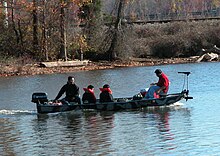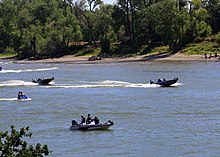
A boat is a watercraft of a large range of types and sizes, but generally smaller than a ship, which is distinguished by its larger size, shape, cargo or passenger capacity, or its ability to carry boats.

A kayak is a small, narrow human-powered watercraft typically propelled by means of a long, double-bladed paddle. The word kayak originates from the Greenlandic word qajaq.
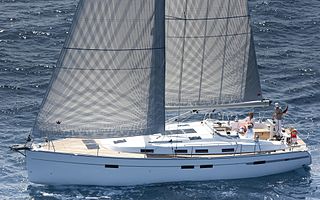
A yacht is a sailing or power vessel used for pleasure, cruising, or racing. There is no standard definition, though the term generally applies to vessels with a cabin intended for overnight use. To be termed a yacht, as opposed to a boat, such a pleasure vessel is likely to be at least 33 feet (10 m) in length and may have been judged to have good aesthetic qualities.

An outboard motor is a propulsion system for boats, consisting of a self-contained unit that includes engine, gearbox and propeller or jet drive, designed to be affixed to the outside of the transom. They are the most common motorised method of propelling small watercraft. As well as providing propulsion, outboards provide steering control, as they are designed to pivot over their mountings and thus control the direction of thrust. The skeg also acts as a rudder when the engine is not running. Unlike inboard motors, outboard motors can be easily removed for storage or repairs.

Trolling is a method of fishing where one or more fishing lines, baited with lures or bait fish, are drawn through the water. This may be behind a moving boat, or by slowly winding the line in when fishing from a static position, or even sweeping the line from side-to-side, e.g. when fishing from a jetty. Trolling is used to catch pelagic fish such as salmon, mackerel and kingfish.

A motorboat, speedboat or powerboat is a boat that is exclusively powered by an engine.

A Drift Boat is an evolution of the open-water dory, converted for use in rivers. The design is characterized by a wide, flat bottom, flared sides, a narrow, flat bow, and a pointed stern. A Rocker is used along an arc from bow to stern along the bottom of the boat. It is this constant rocker that allows the boat to spin about its center for ease in maneuvering in rapids.

A johnboat is a flat-bottomed boat constructed of aluminum, fiberglass, wood, or polyethelene with one, two, or three seats, usually bench type. They are suitable for fishing, hunting and cruising. The nearly flat hull of a johnboat tends to ride over the waves rather than cut through them as a V-hull might; this shallow draft – only a few inches – enables the johnboat to operate in very shallow water, but limits its use to calm waters. Johnboats typically have a transom onto which an outboard motor can be mounted. They are simple and easy to maintain, and inexpensive, though with many options to upgrade. Typical options may include live wells/bait wells, side or center consoles, factory installed decks and floors, electrical wiring, accessory pads/mountings, and casting and poling platforms.

A fishing vessel is a boat or ship used to catch fish in the sea, or on a lake or river. Many different kinds of vessels are used in commercial, artisanal and recreational fishing.

A sailing yacht, is a leisure craft that uses sails as its primary means of propulsion. A yacht may be a sail or power vessel used for pleasure, cruising, or racing. There is no standard definition, so the term applies here to sailing vessels that have a cabin with amenities that accommodate overnight use. To be termed a "yacht", as opposed to a "boat", such a vessel is likely to be at least 33 feet (10 m) in length and have been judged to have good aesthetic qualities. Sailboats that do not accommodate overnight use or are smaller than 30 feet (9.1 m) are not universally called yachts. Sailing yachts in excess of 130 feet (40 m) are generally considered to be superyachts.
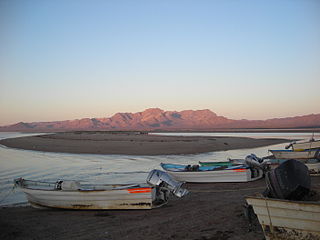
The panga is a type of modest-sized, open, outboard-powered, fishing boat common throughout much of the developing world, including Central America, the Caribbean, parts of Africa, the Middle East, and much of Asia. The original panga design was developed by Yamaha as part of a World Bank project circa 1970. Pangas are commonly operated directly off beaches. The name comes from the panga fish, which is commonly netted. The upswept bow of the boat resembles the machete or knife called a panga.
The North 26 is a boat designed by Julian D Everitt in 1982, Cowes UK, who also designed the E-boat. Big brother to the E-boat, intended for Yacht racing inshore and in Junior Offshore Group races to rate under Channel now IRC measurement rule. Examples race the English Channel and have a wide flat sole plate that enables them to sit the mud in English ports with the keel retracted. This feature also enables safe beach sitting whilst cruising and use as a Trailer yacht.
The Watkins 25, also known as the W25 and marketed as the Seawolf 25 from 1986, is an American trailerable sailboat that was designed by the Watkins Design Team and first built in 1983.
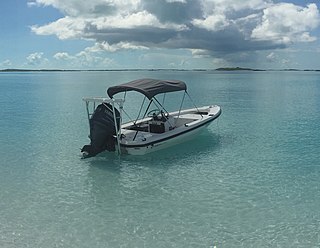
Flats boats are a category of boat designed primarily for fishing in protected, shallow water areas often referred to as "flats" by anglers.
The Allegra 24 is an American trailerable sailboat that was designed by Fred Bingham and Lou Nagy and based upon the work of Fred Bingham's son, Bruce Bingham. The boat is intended as a cruiser and was first built in 1984.
The Bay Hen 21 is an American trailerable sailboat that was designed by Reuben Trane as a pocket cruiser and first built in 1984.
The Dehler 25 is a German trailerable sailboat that was designed by E. G. van de Stadt as a cruiser and first built in 1984.
The Gladiator 24 is an American trailerable sailboat that was designed by Bill Lapworth as a racer-cruiser and first built in 1958.
The Lapworth 24, sometimes called an L24, is an American trailerable sailboat that was designed by Bill Lapworth as a cruiser and first built in 1958.

The Jeanneau Arcachonnais is a French trailerable sailboat that was designed as a day sailer and pocket cruiser, first built in 1969.
